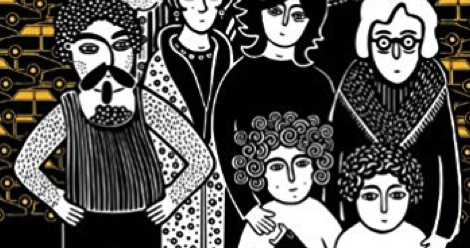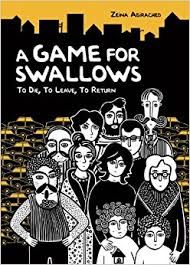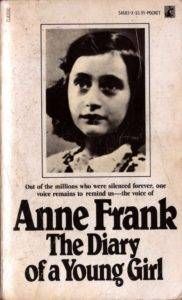
A GAME FOR SWALLOWS and Anne Frank: Narratives of Hidden Children

Around the same time we returned to “Sunday, 14 June, 1942,” recounting Anne’s thirteenth birthday, I picked up A Game for Swallows: To Die, to Leave, to Return by Zeina Abirached, which takes place over a single night in 1984, inside an apartment foyer in East Beirut. Zeina and her younger brother have never known a world that wasn’t fractured by war. In her memory, the bombings, snipers, bullet holes and barricades have always existed. A visit to their grandmother’s house, a few blocks away, has always involved running, sneaking, dodging bullets, and the possibility of death.
The family’s once-spacious apartment has effectively shrunk; the building’s residents have determined that that only truly safe space is the family’s foyer, which is where everyone congregates, especially when the bombardment begins. On the evening in question, the children’s parents have undertaken the treacherous journey to grandmother’s house, and, as the hour grows late and the parents do not return, the other adults in the building gather around, doing their best to create an atmosphere in which the children can feel safe.

Zeina uses the graphic medium to reconstruct the world outside, as it appeared to her during this period: a simple maze of safe and unsafe corners, of barricades that provided safety from the sniper, of dangerous crossing that must be made at top speed. Over and over again, the adults assure her that she is safe as long as she stays within the defined parameters. Anne is somewhat less assured that the Secret Annex is unassailable: her parameters include utter silence when strangers are in the building, periodic burglary scares, and the constant fear of betrayal. Her sense of the world outside the annex is even more fragmented. She hears the clock bells floating through the air and the bombs exploding, and she hungrily devours the news, and she peeks through the curtains, when no one can see.
At the end of Zeina’s story, the safety of the foyer is breached by a bomb; most of the people in her story are inspired to relocate immediately. Anne’s story ends when the annex is raided and its occupants send to concentration camps.
As the hidden children of World War II grew older, they added their narratives to Frank’s. For decades, most of these individuals maintained the silenced they had been taught during the war. Stay inside, make no noise, they learned. For the youngest readers, Patricia Polacco’s The Butterfly, presents the narrative of a girl learning that her mother has been hiding Jews when she meets a little girl who cannot resist the temptation of peeking out the window. Hidden: A Child’s Story of the Holocaust by Loic Dauvillier, Greg Salsedo, and Marc Lizano, presents a hidden child graphic narrative from the point of view of a grandmother who survived the war and shares her history with her grandchild. Today, we can read dozen of stories of children who survived World War II because they were hidden by brave and kind people, and even more written by children who more recently saw their homelands destroyed by war while they watched helplessly and without understanding, as Zeina did.
Meanwhile, my stepdaughter makes just as much noise as she feels like making, and returns to her room and her apps, never twitching the curtain to peek outside unless she’s expecting a car in the driveway. She can go outside whenever she wants, but she rarely wants to, even as she hears Anne’s fervent, unrewarded desires.
















